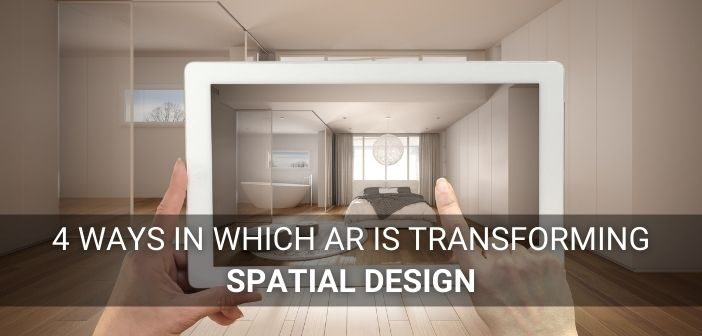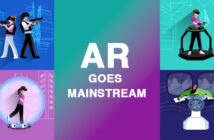With the ability to add another layer to reality, AR is making the process of visualisation easier. One industry that has been deeply affected by the technology’s capability is architecture and design. Even with the plethora of advancements in design tools, a proper rendition of how the building shall look in its environment wasn’t possible till augmented reality caught up. As the instant rendering of graphical elements gets clearer, the ability to project designs as 3D models on the ground through remote devices such as AR goggles and smartphones is catching on in the spatial design community.
Spatial design’s scope of work is massive, from floor mapping to interior design, the process of visualising a living or community space requires a lot of effort due to the 2D nature of the schematics. From designers to engineers and even the investors of architectural projects, AR provides functionality to all the stakeholders. With so many opportunities open for the usage of the technology, there are many startups and applications in the space gaining mass usage in the industry. There is a lot of buzz in the industry regarding the way it can revolutionise the architectural community – and numerous use cases to back it up.
AR for Architecture
With the ability to project 3D objects onto reality, with a field of depth and perspective, architects can easily test run their design as they work on it. With the increased feedback loop and ability to test designs in real-time, the quality of designs go up, as well as the ability to gauge how they will meld into their environment. From rudimentary 3D designs to full-scale renderings, AR apps for designing and testing buildings and architectural design have taken off.

Image Credits: rh2010 from Adobe Stock
ARki is a spatial design application, that has recently incorporated real-time AR projection as a part of their design rendering capabilities – letting architects take their iPad to the construction site and take a good look at how their design will change the landscape. Designed by a former architect, the application incorporates multiple capabilities, materials and lighting solutions in a projectible AR experience. Available on the Apple App Store, the application has received a lot of attention and spotlight during 2020 for its cutting-edge capability and user-friendly design.
Another application that has garnered attention is the AR Sketchwalk application, which lends similar AR design capabilities to architects. With the ability to project entire projects on possible ground zero of structures, designers can have a full-scale view of their own work at the same it provides the unique ability to let multiple designers sync up and be able to walk around the same project.
AR in Construction
Apart from creating architectural designs from scratch, a large part of the architects’ workload is renovating and redesigning older places. With the same capabilities to anchor 3D objects to image anchors through a camera, AR can be applied to real-time measurements and mapping of places and structures. This makes the process of sizing up properties and taking measurements easier and time-effective.

Image Credits: Gorodenkoff from Adobe Stock
An AR application called PLNAR provides such capabilities to its users. Available through the App Store, the AR application lets a user chart out dimensions of a structure by approximating the angles and creating a visual schematic map of the place.
Another such AR-powered floor mapping and measurement app that exists is Google itself. The Google Measure Up app provides users with the capabilities of capturing the dimensions of a place by using the mobile camera to proximate the distance and field of depth.
AR Property Tours
Architectural endeavours are expensive affairs and their effects are long-lasting – making the buyers and investors of such projects very tense. Due to the high degree of specialisation needed to understand architectural schematics and perspective, they have to make decisions from the 2D imaging or computer renders. This tends to make the buyers more skewed towards more conventional designs. With the help of AR, visualization of these projects has become a far easier task to do. Designers can easily share their work in 3D with their clients and be able to deliver better value to them, while at the same time it helps the customer feel assured of the outcome.

Image Credits: Monopoly919 from Adobe Stock
A technology consultancy and marketing firm, Reflective Brands created 3D house tours for their clients in order to help the real estate agency be better able to market their houses to the buyers. With an increasing number of users expressing the desire to see or use an AR model before purchasing, the usage of AR in making potential properties more marketable will help designers be better able to communicate their design and take risks.
AR in Interior Design
With the furniture and interiors bringing the full functionality of houses and buildings to life, interior design is an integral part of spatial design. A part of the design and architectural industry that was affected the most by AR has been interior design, due to its slightly less graphic and technological needs.
There are multiple furniture and fixture giants who have already brought AR tech to the foray for helping customers better visualise the products as if they were already a part of their homes. The most enduring and famous example of AR in interior design has to be Ikea Place, launched just 3 months earlier, the application provides an accuracy of the scale of up to 98%. By letting its users browse their entire catalogue which they can project onto their houses, the company is able to captivate its audience right in their homes.

Image Credits: zapp2photo from Adobe Stock
The enhanced ability to visualise products and environments around us is going to shape the upcoming century of design and architecture. AR had been one of the most awaited technologies in the design world and now it’s here, the industry is going through a paradigm shift in its way of operating in all functions.




